
Do you hold tension and stress in your shoulders? Sitting hunched over a computer or smart phone for hours every day, often with poor posture, can cause incredible tension in our shoulders and chest.
We usually feel the tightness and pain in our shoulders, but it is often coming from tightness around the chest area, so it's helpful to stretch and open across the chest as well.
Although some of this tension may be caused by poor physical posture, I believe that much of the tension is caused by mental or emotional stress that we are holding onto in our bodies, manifesting physical tension and pain.
Around 80% of my clients that come to see me for a massage, complain about tightness in their shoulders. I always ask if they sit at a computer all day, and the answer is more often than not, 'yes'.
This article describes my favorite Yoga poses and stretches that will help to release the tension in your shoulders. It is part of a series of 'Yoga Poses for Reducing Aches and Pains'.
I recommend doing this sequence using the breathing as mentioned below, then progressing to holding each pose for a little longer, up to twice the number of breaths mentioned below.
Remember to listen to your body and breathe slowly and deeply. If any pose doesn't feel good or if you are experiencing discomfort or pain, please release out of the pose and leave a comment in the comments section below and I'll be sure to respond.
Seated Cat Pose (Marjaryasana) and Seated Cow Pose (Bitilasana)
Seated Cat and Cow is similar to regular Cat and Cow except there is more emphasis on opening and stretching the shoulders in these seated versions. Take a deep inhale as you wrap your arms around your back, interlace the fingers and arch the back slightly, gazing forwards and lifting the hands up at the back, into Seated Cow Pose. Keep the shoulders down away from the ears and draw the shoulder blades together. Take a deep exhale as you bring the arms in front, interlace the fingers and round the back, pressing the palms away from you, drawing the belly back towards the spine and the chin to the chest, into Seated Cat Pose, still keeping the shoulders relaxed and down away from the ears. Repeat 5 rounds, using the breath as you inhale to Seated Cow Pose and exhale to Seated Cat Pose.


Seated Eagle Arms (Garudhasana) Variation
Wrap the right elbow underneath the left and place the palms together, or the back of the hands, whichever you can reach, keeping the fingers pointing up and the wrists straight. Inhale as you lift the elbows up, and exhale as you gently draw the hands and forearms away from the face, breathing into the back of the shoulders. Keep drawing the shoulders down away from the ears, relaxing the shoulders. Either stay with this version of the pose, or slowly begin to fold forwards into a slightly deeper version, using the breath to guide you. Keep drawing the hands and forearms down towards the floor to deepen the stretch across the back of the shoulders. Hold and breathe for 5 long deep breaths. Slowly come back up and switch sides, wrapping the left elbow underneath the right.


Thread the Needle
Come onto hands and knees, place the left hand into the middle of the mat underneath the chest, inhale as you extend the right arm up to the right, exhale as you thread the right arm all the way underneath the left arm, keeping length in the right arm as you thread. Lower the outside of the right shoulder and the right ear onto the mat, keeping the hips up high. You can either keep your let hand on the mat in front of your face or straighten your left arm and stretch it up overhead with the palm on the mat (the two variations are shown below). Hold and breathe for 5 long deep breaths. Switch sides.



Chest Opener
Lower all the way down onto your belly and place your left arm out in a T shape, at 90 degrees to the body, palm facing down. Pressing the right hand into the mat, roll over onto your left side, pressing the front of your left shoulder into the mat, keeping your left ear on the mat. You can stay in this version of the pose or if you wish to go deeper, extend the right arm up and around the back towards the left arm, keeping the right arm at shoulder height. You can also bend your right knee and place your foot on the mat behind your left leg so you can roll over more onto your left side body. Hold and breathe for 5 long deep breaths, breathing into your left shoulder and across the chest. Release and roll back onto your belly. Switch sides.
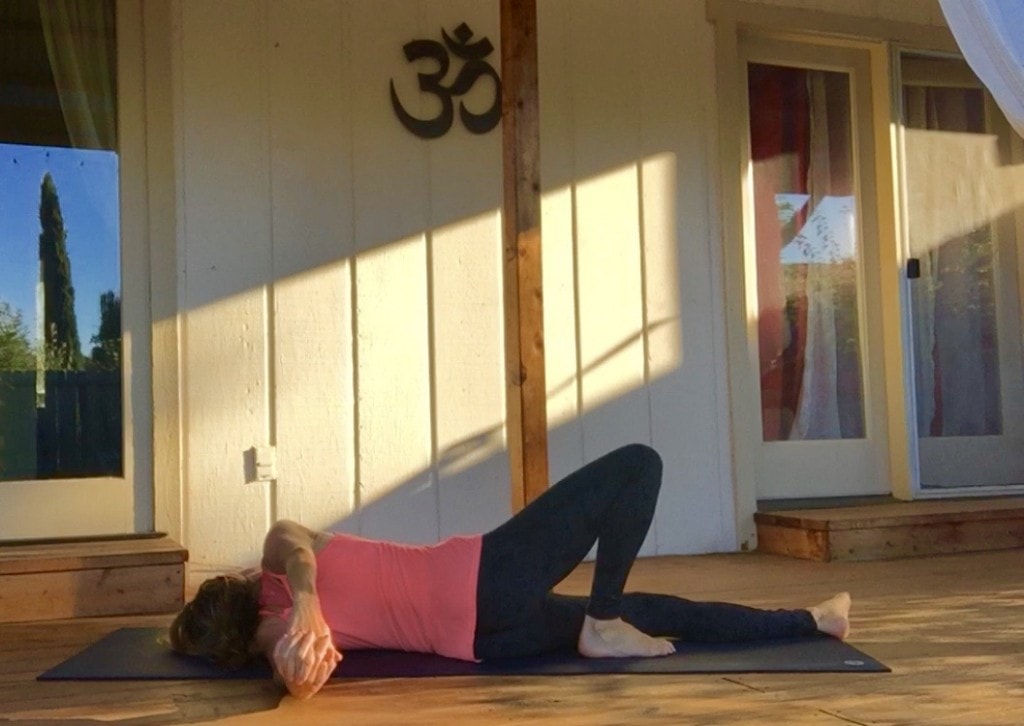
Downward Facing Dog (Adho Mukha Svanasana)
Come back up onto hands and knees, tuck the toes under, lift the hips up high, into Downward Facing Dog, an upside down V shape. Spread the fingers wide, pressing into all 10 fingers, particularly the thumb and first finger. Place your hands a little wider than shoulder width, and feet about hip width. Press the heels to the mat as you lift the kneecaps to engage the quadriceps, draw the belly up towards the spine to engage the core, press the sit bones up towards the sky, push the floor away with the palms and draw the heart towards the thighs. Create space in the upper back by rotating the triceps towards each other, and shoulders away from the ears. Hold and breathe for 5 long deep breaths.
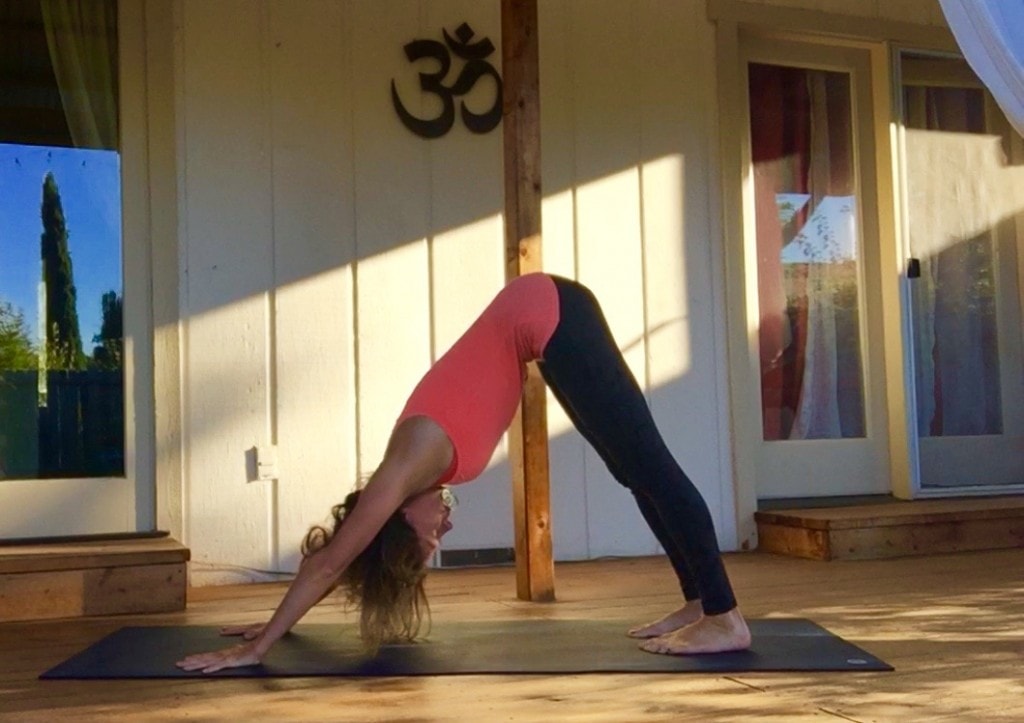
Dolphin (Makarasana)
From Downward Facing Dog, lower onto your forearms, with the forearms parallel to one another and the palms face down. Press the forearms and the palms down into the mat as you press the shoulders away from the ears, creating space around the shoulders. Begin to walk the feet a little closer to the elbows. Feel the strength of the shoulders and breathe into the shoulders. Keep drawing the sit bones up high, legs engaged and the thighs towards the chest. Hold and breathe for 5 long deep breaths.
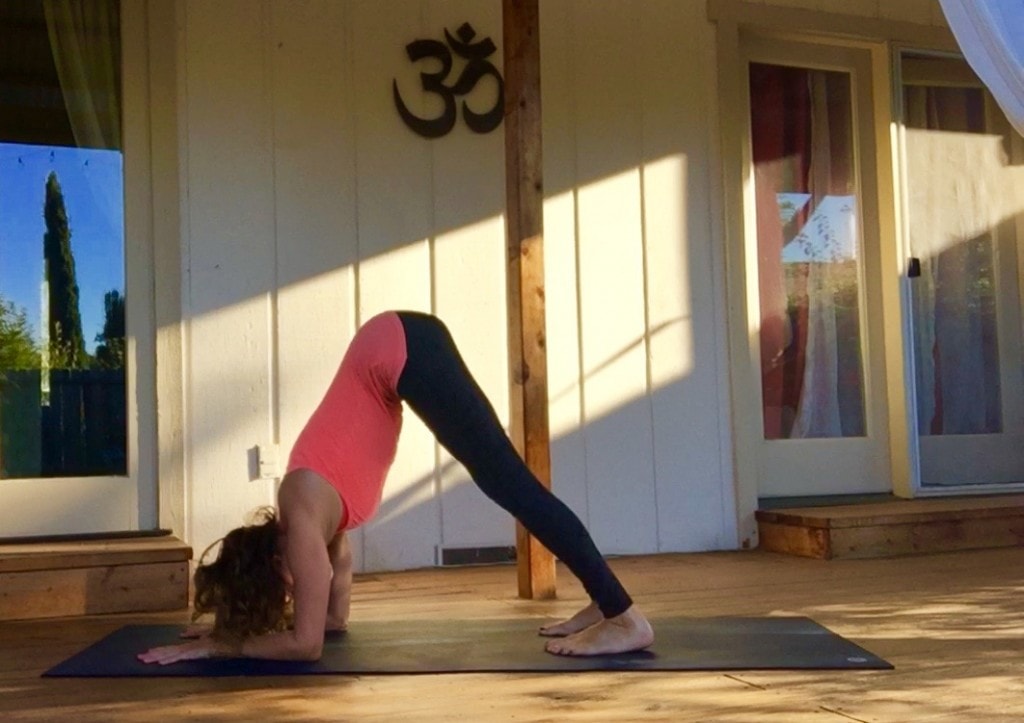
Cobra (Bhujangasana)
Lower down onto your belly, place your hands underneath your shoulders on the mat, as you inhale press into your hands and lift your chest and head up off the mat, keeping your hips and legs low. Keep a small bend in your arms, roll your shoulders down away from your ears, draw your shoulder blades together and open across the chest. Hold and breathe for 5 long deep breaths, relaxing the low back and breathing into your low back. Lower back down onto your belly and take a Child's Pose to release the low back.
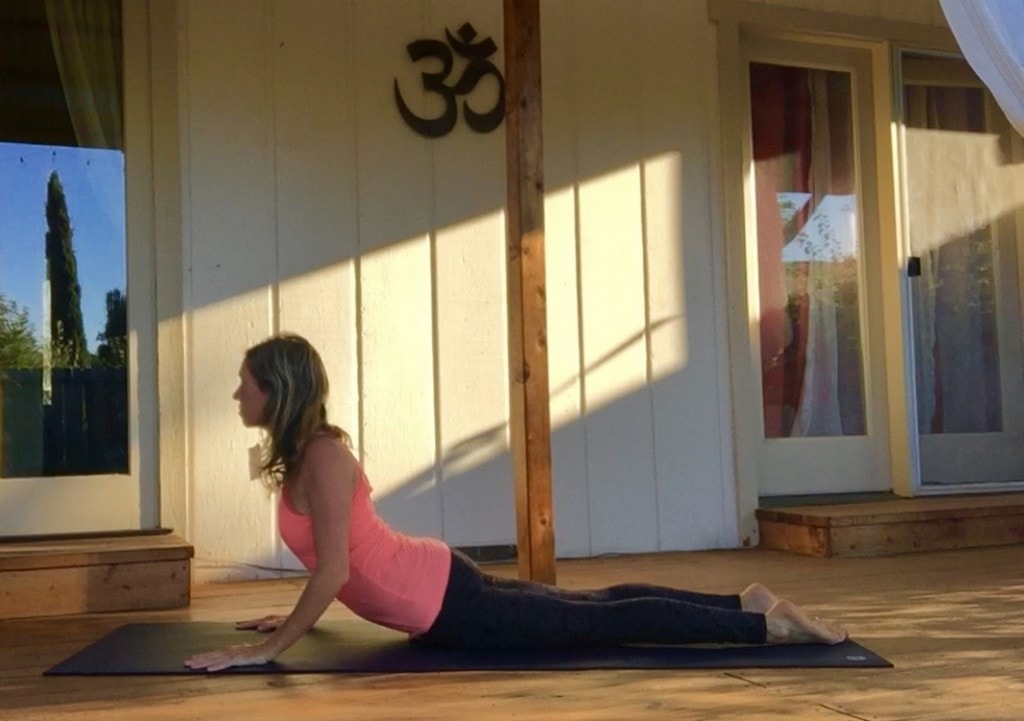
Wide Legged Forward Fold Pose (Prasarita Padottanasana)
Variation 1 - From standing, step the left foot back about 3 feet, turning both feet in slightly so you're a little pigeon toed. Press into the outside of the feet to straighten the legs. Wrap the arms around the back, interlace the fingers, inhale as you take a small lean back and lengthen the spine, exhale as you fold forward from the hip crease, lowering the head towards the mat and extending the arms overhead, as shown. Try to keep the legs straight if you can or you can soften the knees a little to modify. Hold and breathe for 5 long deep breaths. Inhale to come back up to standing.
Variation 2 - If you'd like to try a deeper variation, place the palms together in prayer position behind the back, as shown. Inhale as you lengthen the spine, exhale as you fold forward, keeping the shoulders away from the ears and draw the shoulder blades together. Hold and breathe for 5 long deep breaths. Inhale to come back up to standing.
Variation 3 - For a more advanced variation, raise the right arm up overhead, bend the elbow and draw the hand down the back. Bend the left elbow and place the hand behind the back and see if you can reach the hands together. If you can't take a hold of your hands, you can use a strap, rope or rolled up towel. Inhale as you lengthen the spine, exhale as you fold forward. Hold and breathe for 5 long deep breaths. Inhale to come back up to standing. Switch sides.
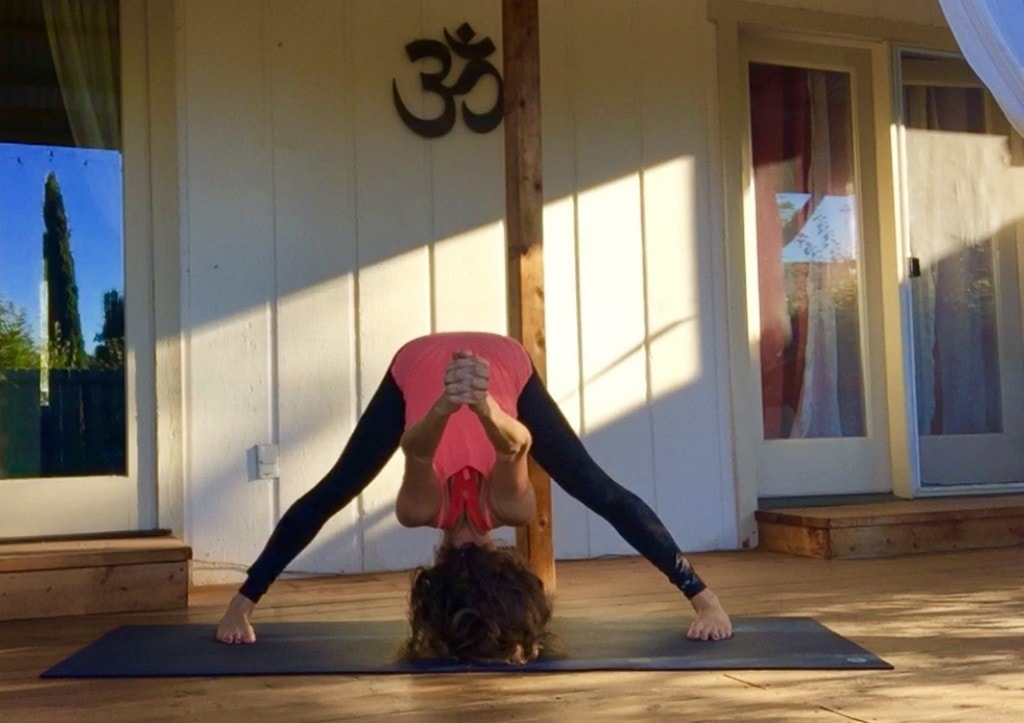
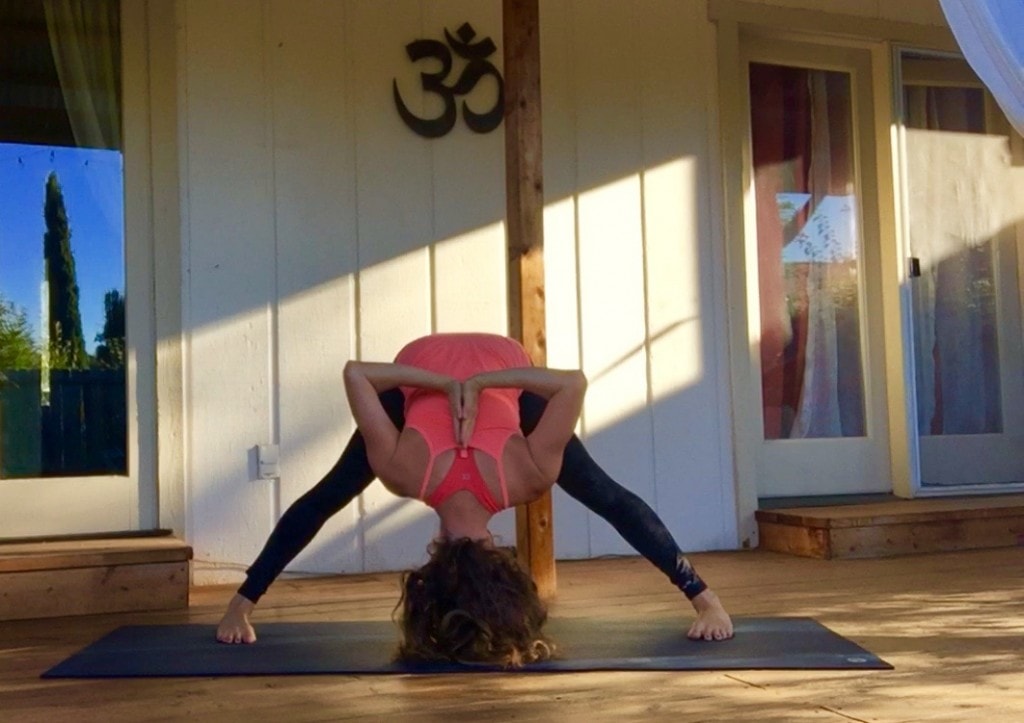
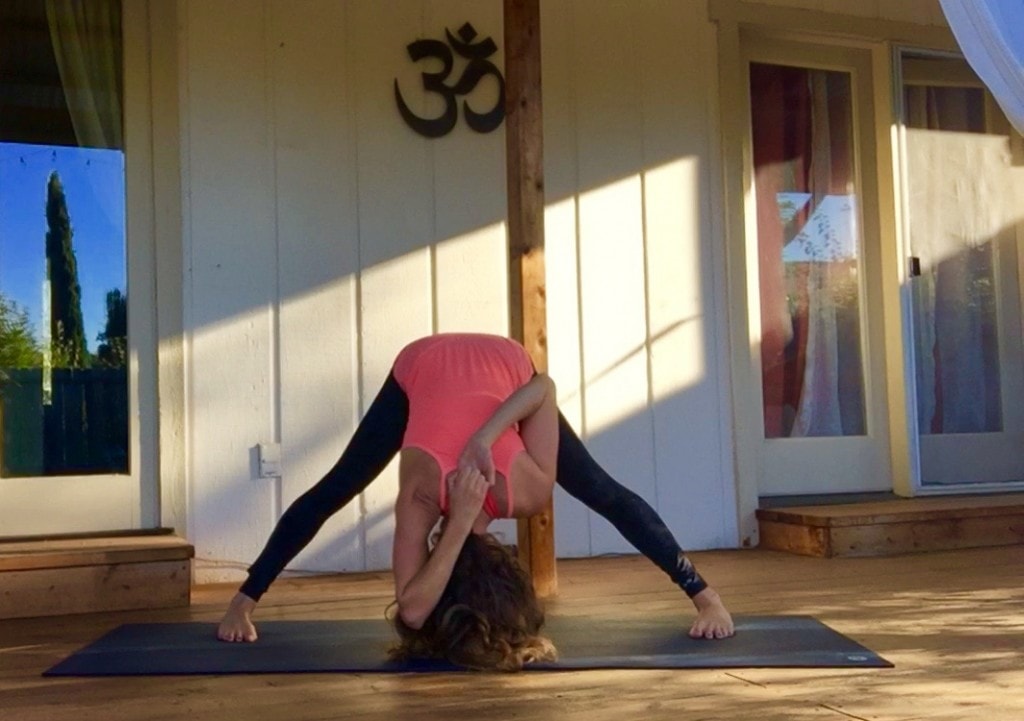
Locust (Salabhasana) variation
Lie down on your belly, wrap your arms around your back and interlace your fingers. Inhale as you lift the chest, head and shoulders up off the mat, drawing the arms back and opening the shoulders and chest. Keep drawing the hands towards the feet. You can either stay with this variation or also lift the legs for a more advanced version of the pose. Hold and breathe for 5 long deep breaths.
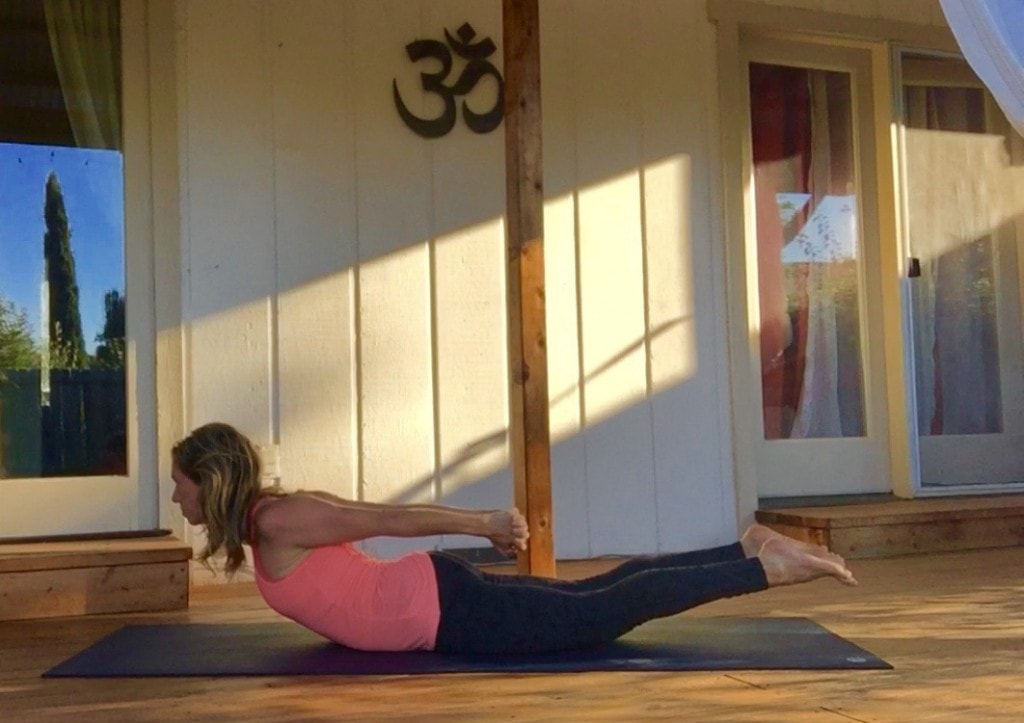
Bridge (Setu Bandhasana)
Lie on your back, bend your knees and place the feet firmly on the mat hip width apart, close to the sit bones so the fingers can brush alongside the heels. Inhale as you lift the hips and back up off the mat, squeeze the shoulders towards each other underneath the torso, and interlace the fingers underneath the hips. Keep pressing the shoulders and feet firmly down to the mat as you lift the hips up nice and high. Keep the gaze straight up towards the ceiling. Draw the chin back away from the chest and the chest back towards the chin. Squeeze the shoulder blades together under the torso. Hold and breathe for 5 long deep breaths.

Childs Pose (Balasana) Variation
Roll over onto your hands and knees, then place the knees to the sides of the mat and the big toes together, sink the hips back into the heels and place the forehead on the mat for Child's Pose. For this variation that will stretch out the shoulders more, bend the elbows and place the elbows on the mat (or on a block for a deeper stretch) with the palms together above your head. Press the shoulders down towards the mat for a nice deep shoulder stretch. Hold and breathe for 5 long deep breaths.
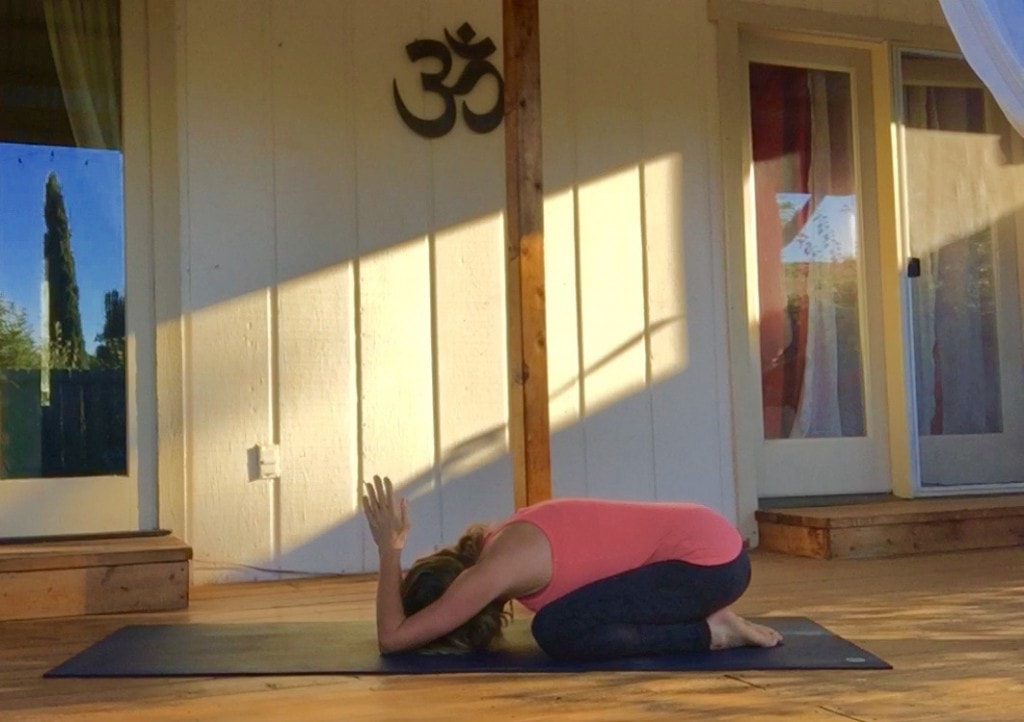
Savasana
It's important to always finish any yoga sequence with our final resting pose, Savasana. Lie on your back, close your eyes, let the whole body be relaxed and still, arms a little away from the body, with the palms facing up. Bring your internal gaze to your third eye chakra in between your eyebrows and visualize a bright white light at that space, area of intuition and wisdom. Remain here in Savasana for a few minutes or as long as you wish, before slowly and gently deepening your breath, finding some movement back in your body, rolling onto your right side then slowly coming into a seated position. Bring your palms together at your heart center. Namaste.
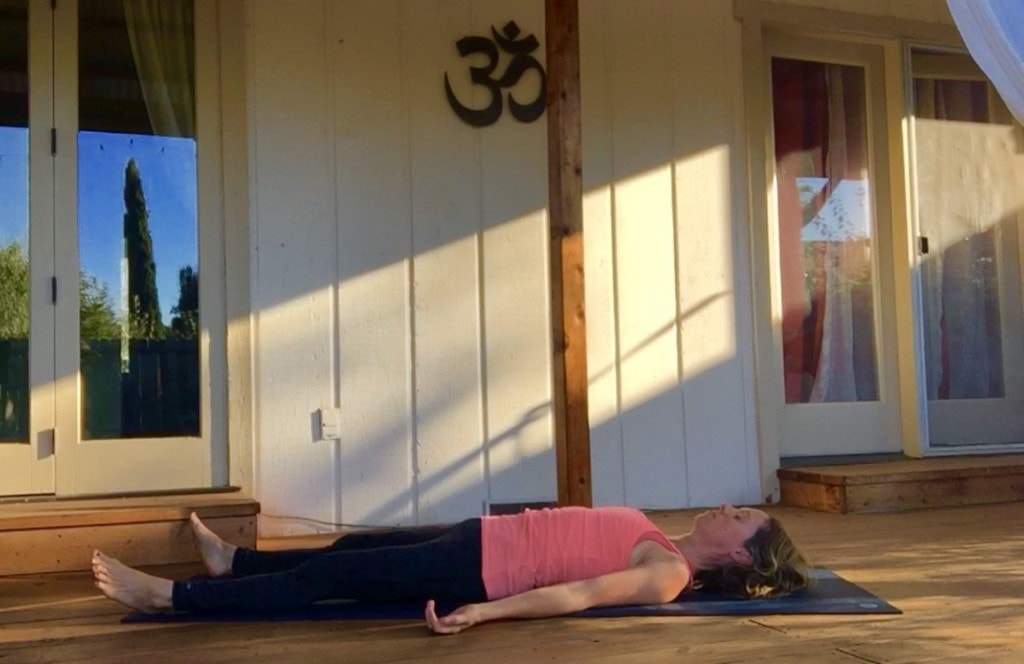
I hope these postures helped your shoulder pain. If you would like some more shoulder strength building exercises, I recommend checking out our Yoga Postures for Shoulder Strength article. Practicing the postures in both sequences is important to help with both shoulder flexibility and strength, so you can build strong and open shoulders. Listen to your body and only do the exercises that feel good and do not cause or trigger any pain.
Feel free to follow along with our Online Yoga Class Videos for more postures that may help ease shoulder pain.
Feel free to leave any comment and questions in the comments section below and share with your friends on social media if you found this article helpful.
Author: Sally Mitchell, founder of Body Flows Yoga Retreats and RYT 200 Yoga Teacher leads yoga retreats in California, Colorado, Arizona, Oregon, Hawaii, Mexico and Costa Rica. Living in beautiful Sonoma, California, after 15 years in NYC and San Francisco, her approach as a leader and teacher is holistic, balanced and grounded. She enjoys practicing and studying Yoga and Buddhism, hiking and trail running in nature, traveling, writing and inspiring others to live a more spiritual and meaningful life.
The Body Flows website contains information intended to assist you in improving your health and overall well being, however, the information presented herein is offered for informational and educational purposes only and is not a substitute for the professional judgment of a medical professional.
Body Flows makes no warranty or representation whatsoever regarding the services or products provided through or in connection with the website. Please use your own discretion when performing any postures. Work at your own level and explore your own limits.
The reader and viewer of the information presented by this site assumes all risks when using the information provided herein. This site's operators, authors, owners, and affiliates disclaim any and all liability from the information provided herein. Any medical, financial, legal, health, psychological or other information provided on this site is not intended as a replacement for professional consultations with qualified practitioners. If this site provides health-related or medical information, no such information provided by this site is intended to treat or cure any disease or to offer any specific diagnosis to any individual as we do not give medical advice, nor do we provide medical or diagnostic services.
We recommend that you seek professional medical advice before performing any techniques, poses, postures or routines presented on our site. We thank you for visiting us and want the best for you, your practice and your health.